The Study of Airborne Particulate Matter in Dalnegorsk Town
Abstract
:1. Introduction
2. Materials and Methods
2.1. Snow Cover Samples
2.2. Determination of Particle Size Distribution in Snow Samples
2.3. Conifer Needle Samples
2.4. Determination of PM from Dried Residue and Reference Material
2.5. Ore Mineral Samples
2.6. Imaging, Morphometry, and Microanalysis of Metal Particles
2.7. Study Area
3. Results
3.1. Snow Cover Studies
3.2. Study of Washout from Vegetation Samples (Conifer Needles)
4. Discussion
5. Conclusions
Author Contributions
Funding
Institutional Review Board Statement
Informed Consent Statement
Data Availability Statement
Conflicts of Interest
References
- Yamagishi, N.; Yamaguchi, T.; Kuga, T.; Taniguchi, M.; Khan, M.S.; Matsumoto, T.; Deguchi, Y.; Nagaoka, H.; Wakabayashi, K.; Watanabe, T. Development of a system for the detection of the inflammatory response induced by airborne fine particulate matter in rat tracheal epithelial cells. Toxicol. Rep. 2020, 7, 900–908. [Google Scholar] [CrossRef]
- Brook, R.D.; Franklin, B.; Cascio, W.; Hong, Y.; Howard, G.; Lipsett, M.; Luepker, R.; Mittleman, M.; Samet, J.; Smith, S.C., Jr.; et al. Air pollution and cardiovascular disease: A statement for healthcare professionals from the Expert Panel on Population and Prevention Science of the American Heart Association. Circulation 2004, 109, 2655–2671. [Google Scholar] [CrossRef]
- Kim, D.; Chen, Z.; Zhou, L.-F.; Huang, S.-X. Air pollutants and early origins of respiratory diseases. Chronic Dis. Transl. Med. 2018, 4, 75–94. [Google Scholar] [CrossRef] [PubMed]
- Veremchuk, L.V.; Tsarouhas, K.; Vitkina, T.I.; Mineeva, E.E.; Gvozdenko, T.A.; Antonyuk, M.V.; Rakitskii, V.N.; Sidletskaya, K.A.; Tsatsakis, A.M.; Golokhvast, K.S. Impact evaluation of environmental factors on respiratory function of asthma patients living in urban territory. Environ. Pollut. 2018, 235, 489–496. [Google Scholar] [CrossRef]
- Pelucchi, C.; Negri, E.; Gallus, S.; Boffetta, P.; Tramacere, I.; La Vecchia, C. Long-term particulate matter exposure and mortality: A review of European epidemiological studies. BMC Public Health 2009, 9, 453. [Google Scholar] [CrossRef]
- Sadeghi, M.; Ahmadi, A.; Baradaran, A.; Masoudipoor, N.; Frouzandeh, S. Modeling of the relationship between the environmental air pollution, clinical risk factors, and hospital mortality due to myocardial infarction in Isfahan, Iran. J. Res. Med. Sci. 2015, 20, 757–762. [Google Scholar] [CrossRef]
- Tsatsakis, A.; Petrakis, D.; Nikolouzakis, T.K.; Docea, A.O.; Calina, D.; Vinceti, M.; Goumenou, M.; Kostoff, R.N.; Mamoulakis, C.; Aschner, M.; et al. COVID-19, an opportunity to reevaluate the correlation between long-term effects of anthropogenic pollutants on viral epidemic/pandemic events and prevalence. Food Chem. Toxicol. 2020, 141, 111418. [Google Scholar] [CrossRef]
- Adams, K.; Greenbaum, D.S.; Shaikh, R.; van Erp, A.M.; Russell, A.G. Particulate matter components, sources, and health: Systematic approaches to testing effects. J. Air Waste Manag. Assoc. 2015, 65, 544–558. [Google Scholar] [CrossRef]
- Cruz, A.M.; Sarmento, S.; Almeida, S.M.; Silva, A.V.; Alves, C.; Freitas, M.C.; Wolterbeek, H. Association between atmospheric pollutants and hospital admissions in Lisbon. Environ. Sci. Pollut. Res. Int. 2015, 22, 5500–5510. [Google Scholar] [CrossRef]
- Badyda, A.; Gayer, A.; Czechowski, P.O.; Majewski, G.; Dąbrowiecki, P. Pulmonary Function and Incidence of Selected Respiratory Diseases Depending on the Exposure to Ambient PM(10). Int. J. Mol. Sci. 2016, 17, 1954. [Google Scholar] [CrossRef] [Green Version]
- Salvador, P.; Almeida, S.M.; Cardoso, J.; Almeida-Silva, M.; Nunes, T.; Cerqueira, M.; Alves, C.; Reis, M.A.; Chaves, P.C.; Artíñano, B.; et al. Composition and origin of PM10 in Cape Verde: Characterization of long-range transport episodes. Atmos. Environ. 2016, 127, 326–339. [Google Scholar] [CrossRef]
- Lin, Y.; Zou, J.; Yang, W.; Li, C.-Q. A Review of Recent Advances in Research on PM(2.5) in China. Int. J. Environ. Res. Public Health 2018, 15, 438. [Google Scholar] [CrossRef] [Green Version]
- Rogula-Kozłowska, W. Size-segregated urban particulate matter: Mass closure, chemical composition, and primary and secondary matter content. Air Qual. Atmos. Health 2015, 9, 533–550. [Google Scholar] [CrossRef] [PubMed] [Green Version]
- Onat, B.; Alver Şahin, Ü.; Bayat, C. Assessment of particulate matter in the urban atmosphere: Size distribution, metal composition and source characterization using principal component analysis. J. Environ. Monit. 2012, 14, 1400–1409. [Google Scholar] [CrossRef] [PubMed]
- Turchaninov, I.A.; Krasnoselsky, E.B.; Klyuchnikova, A.M.; Talalaev, S.M. The problems of fastening the dust-forming surface of the active tailing dumps in the Polar region. Eng. Geol. 1981, 5, 4. [Google Scholar]
- Tarasenko, I.A.; Kharitonova, N.A.; Zin’kov, A.V.; Ovodova, E.V.; Korzun, A.V. Tailing dumps at the Krasnorechenskaya concentration mill (Primorskii krai, Russia): Geochemistry and mineralogy. Mosc. Univ. Geol. Bull. 2017, 72, 192–199. [Google Scholar] [CrossRef]
- Zvereva, V.P.; Zarubina, N.V. The mining technogenic system of the Dalnegorsk district of the Far East and its impact on the ecosphere. Geoecol. Eng. Geol. Hydrogeol. Geocryol. 2008, 6, 500–505. [Google Scholar]
- Siudek, P.; Frankowski, M.; Siepak, J. Trace element distribution in the snow cover from an urban area in central Poland. Environ. Monit. Assess. 2015, 187, 225. [Google Scholar] [CrossRef] [Green Version]
- Freer-Smith, P.H.; Beckett, K.P.; Taylor, G. Deposition velocities to Sorbus aria, Acer campestre, Populus deltoides X trichocarpa ‘Beaupré’, Pinus nigra and X Cupressocyparis leylandii for coarse, fine and ultra-fine particles in the urban environment. Environ. Pollut. 2005, 133, 157–167. [Google Scholar] [CrossRef]
- Kholodov, A.; Zakharenko, A.; Drozd, V.; Chernyshev, V.; Kirichenko, K.; Seryodkin, I.; Karabtsov, A.; Olesik, S.; Khvost, E.; Vakhnyuk, I.; et al. Identification of cement in atmospheric particulate matter using the hybrid method of laser diffraction analysis and Raman spectroscopy. Heliyon 2020, 6, e03299. [Google Scholar] [CrossRef] [PubMed]
- Ault, A.P.A.; Lynne, J. Atmospheric Aerosol Chemistry: Spectroscopic and Microscopic Advances. Anal. Chem. 2016, 89, 430–452. [Google Scholar] [CrossRef] [PubMed]
- Karagulian, F.; Belis, C.A.; Dora, C.F.C.; Prüss-Ustün, A.M.; Bonjour, S.; Adair-Rohani, H.; Amann, M. Contributions to cities’ ambient particulate matter (PM): A systematic review of local source contributions at global level. Atmos. Environ. 2015, 120, 475–483. [Google Scholar] [CrossRef]
- Kiku, P.F.; Bienova, S.N.; Geltser, B.I. Habitat and Ecologically Dependent Human Diseases; Far Eastern Federal University: Vladivostok, Russia, 2017. [Google Scholar]
- Kiku, P.F.; Moreva, V.G.; Kondrat’ev, K.V.; Sabirova, K.M.; Alekseeva, G.N.; Veremchuk, L.V. A comprehensive assessment of the spread of cancer in the Primorsky Region. Semashko Bull. Natl. Res. Inst. Public Health 2017, 1, 5. [Google Scholar]
- Belik, L.A. Hygienic Aspects of Respiratory Diseases of the population in Industrial Centers of Primorsky Krai. Dissertation’s Thesis, Vladivostok State Medical University, Vladivostok, Russia, 2003. [Google Scholar]
- Kiku, P.F.; Veremchuk, L.V. Comprehensive hygienic assessment of the environment and human health in the Primor’e Territory. Gig. Sanit. 2002, 3, 16–21. [Google Scholar]
- Statistical Data on the State and Dynamics of Health Care in the Primorsky Krai. Available online: https://primorsky.ru/regionalnye-proekty/zdravookhranenie (accessed on 26 May 2021).
- Tarasenko, I.A.; Zin’kov, A.V.; Kholodov, A.S.; Riaz, M.; Petukhov, V.I.; Popov, N.Y.; Tsatsakis, A.; Golokhvast, K.S. Concentrating Mill Wastes are the Source of Pollution of Human Environment and Natural Ecosystems with Heavy Metals: A Case Study in Primorsky Krai, Russian Federation. J. Chem. 2020, 2020, 6570126. [Google Scholar] [CrossRef]
- Safina, N.P.; Melekestseva, I.Y.; Ayupova, N.R.; Maslennikov, V.V.; Maslennikova, S.P.; Artemyev, D.A.; Blinov, I.A. Authigenesis at the Urals Massive Sulfide Deposits: Insight from Pyrite Nodules Hosted in Ore Diagenites. Minerals 2020, 10, 193. [Google Scholar] [CrossRef] [Green Version]
- Zvereva, V.; Lysenko, A.; Frolov, K. Modern Minerals Formation Genesis in Kavalerovsky Tin–Ore District Technogenic System (Primorsky Krai). Minerals 2020, 10, 91. [Google Scholar] [CrossRef] [Green Version]
- Amirabadi, F.; Tabrizian, K.; Rashki, A.; Rezaee, R.; Tsatsakis, A.M.; Arsene, A.L.; Docea, A.O.; Moshiri, M.; Hashemzaei, M. Lead Levels in Children Deciduous Teeth are Associated with Parents’ Education Status and Daily Dairy Consumption: An Iranian Experience. Farmacia 2016, 64, 202–209. [Google Scholar]
- Marinescu, E.; Elisei, A.M.; Aprotosoaie, A.C.; Cioanca, O.; Trifan, A.; Miron, A.; Robu, S.; Ifrim, C.; Hancianu, M. Assessment of Heavy Metals Content in Some Medicinal Plants And Spices Commonly Used In Romania. Farmacia 2020, 68, 1099–1105. [Google Scholar] [CrossRef]
- Oliver, M.A. Soil and human health: A review. Eur. J. Soil Sci. 1997, 48, 573–592. [Google Scholar] [CrossRef]
- Abdul, K.S.; Jayasinghe, S.S.; Chandana, E.P.; Jayasumana, C.; De Silva, P.M. Arsenic and human health effects: A review. Environ. Toxicol. Pharm. 2015, 40, 828–846. [Google Scholar] [CrossRef] [PubMed]
- Kabir, T.; Anwar, S.; Taslem Mourosi, J.; Hossain, J.; Rabbane, M.G.; Rahman, M.M.; Tahsin, T.; Hasan, M.N.; Shill, M.C.; Hosen, M.J. Arsenic hampered embryonic development: An in vivo study using local Bangladeshi Danio rerio model. Toxicol. Rep. 2020, 7, 155–161. [Google Scholar] [CrossRef] [PubMed]

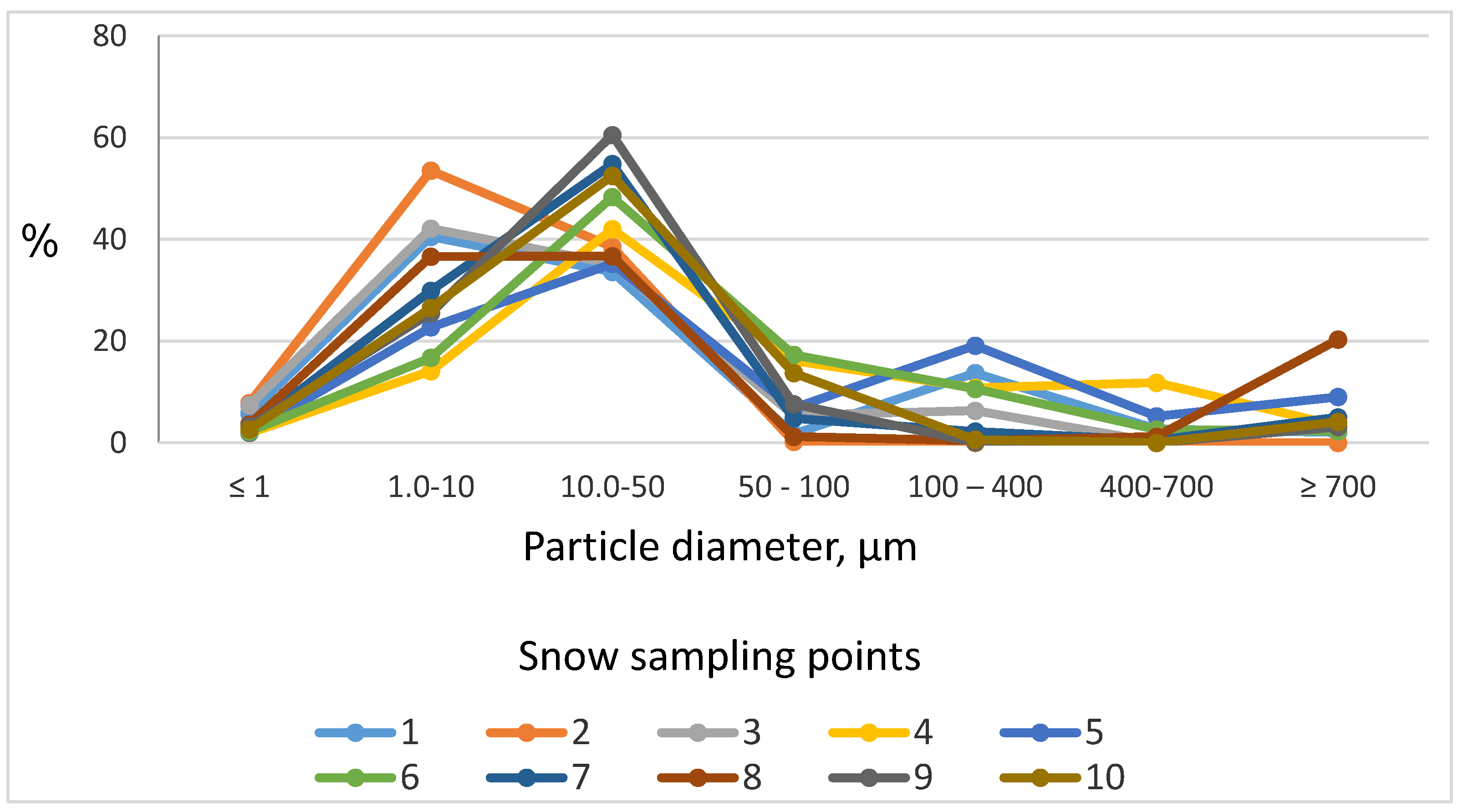
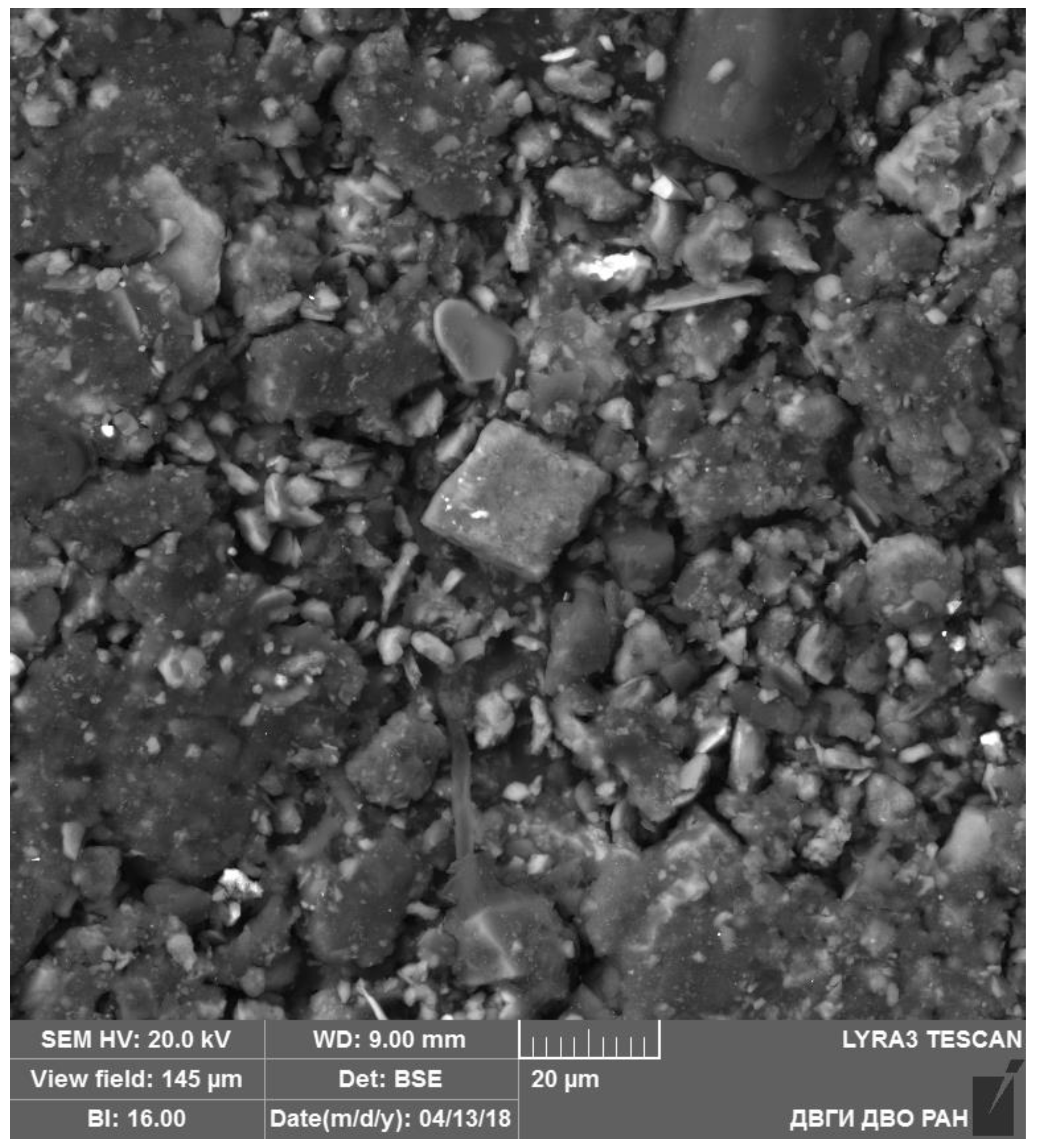
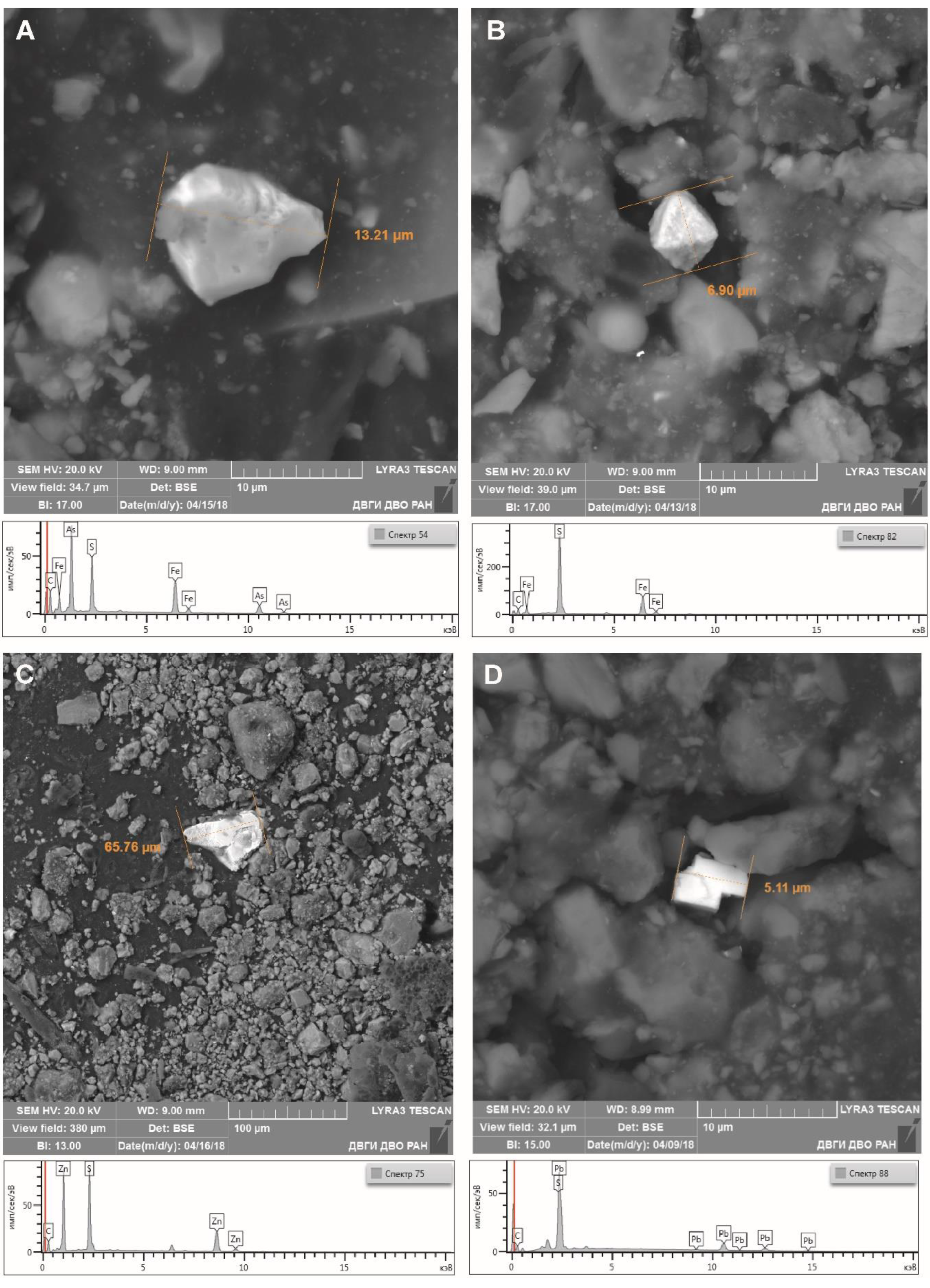
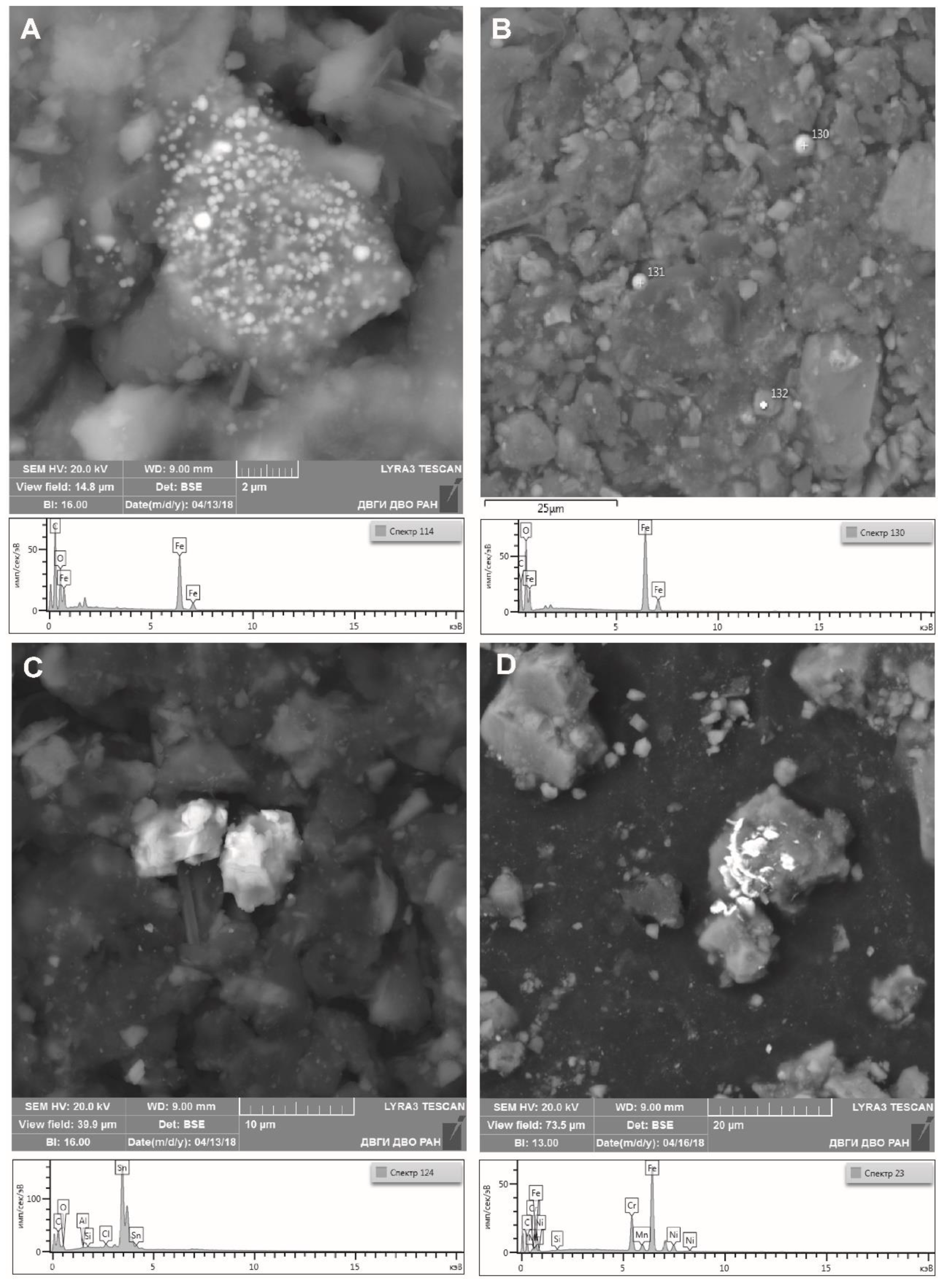
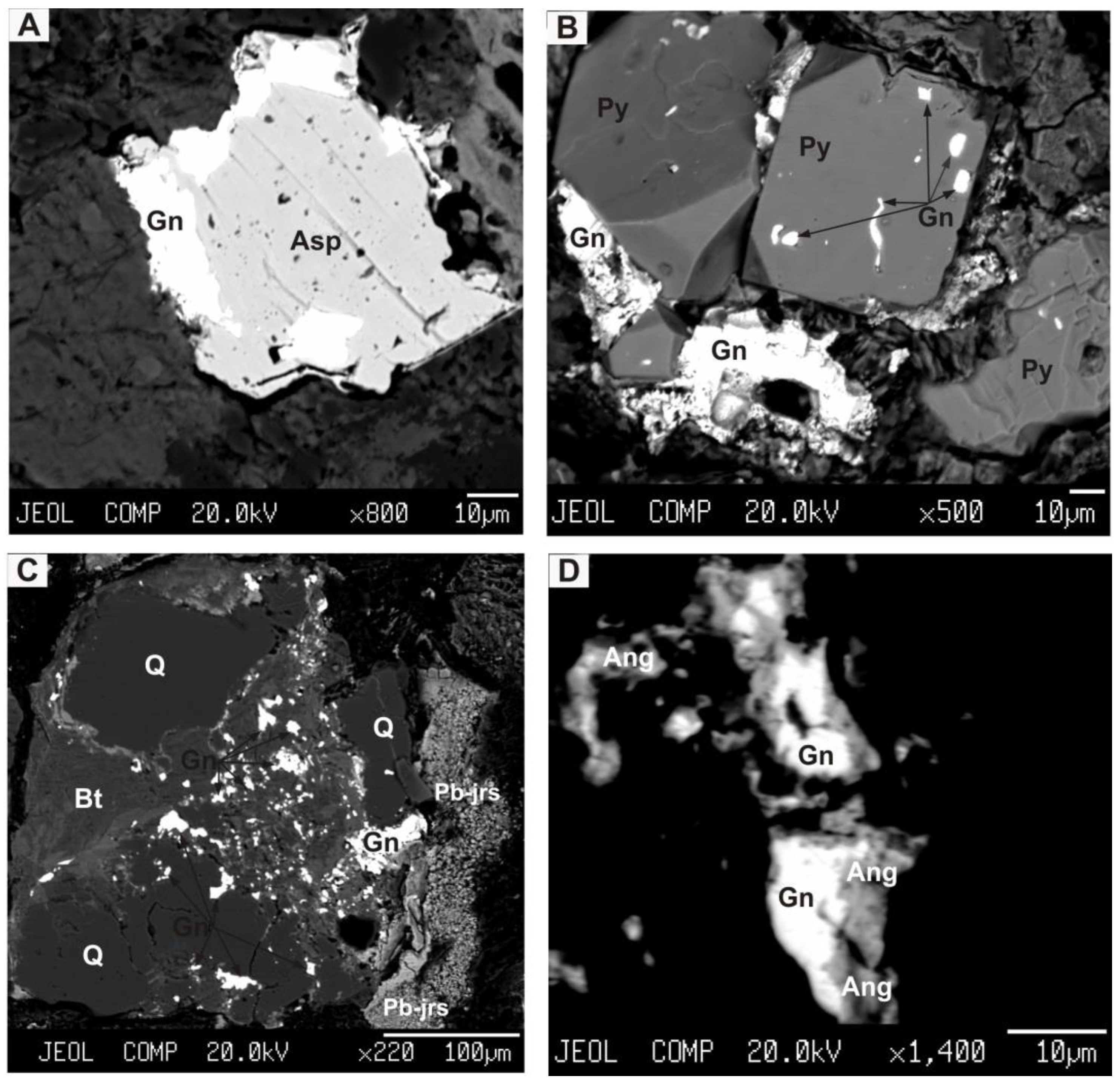
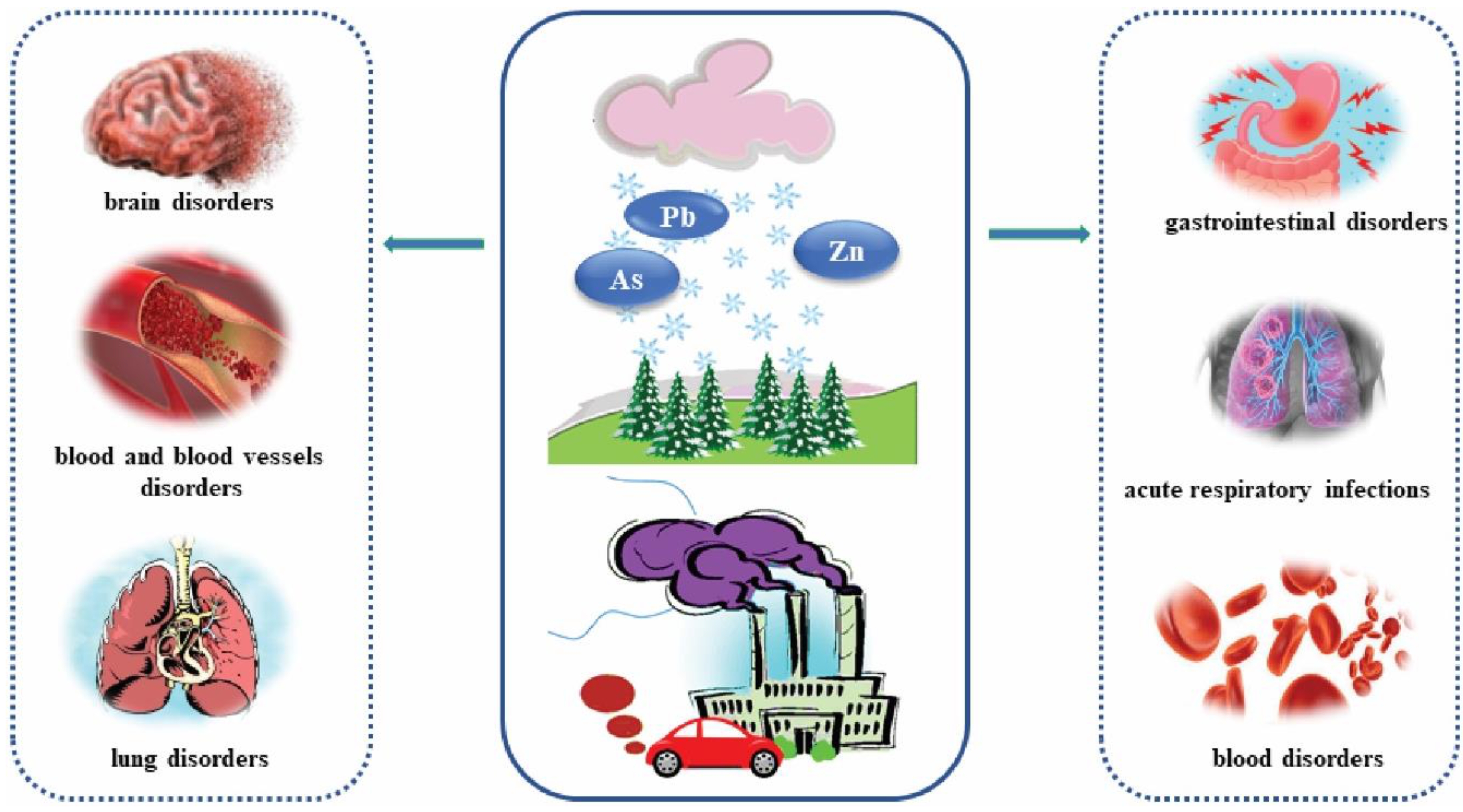
| Sampling Point No. | Description of Sampling Point |
|---|---|
| Snow cover sampling points | |
| 1 | Pionerskaya Str., snow sampling point near the stadium |
| 2 | Residential area on 50 Let Oktyabrya Ave., 20 m from the road |
| 3 | Residential area, sampling point on Polina Osipenko Blvd |
| 4 | Forested area, background point |
| 5 | Park area |
| 6 | Sampling point near a private residential building on 6 Sovetskaya Str |
| 7 | Front yard of a building on 50 Let Oktyabrya Ave. 15 m from the road |
| 8 | Private residential building on Sovetskaya Str |
| 9 | Country road |
| 10 | Private residential building on 50 Let Oktyabrya Ave. 15 m from the road |
| Vegetation samples (conifer needles) | |
| 1 | Town center, sampling point near the house on 64 Pionerskaya Str |
| 2 | Near “Bor” enterprise, 30 m from the road on the outskirts of the town |
| 3 | City center, 10 m from the road |
| 4 | The southern end of town, outskirts of the private sector. Background point in the forest on a hill, 550 m from the road |
| Sampling Point No. | Diameter μm | ||||||
|---|---|---|---|---|---|---|---|
| ≤1 | 1–10 | 10–50 | 50–100 | 100–400 | 400–700 | ≥700 | |
| Percentage of Fraction (Distribution by Number) | |||||||
| 1 | 5.8 | 40.5 | 33.6 | 1.7 | 13.7 | 2.7 | 2 |
| 2 | 7.8 | 53.5 | 38.5 | 0.2 | 0 | 0 | 0 |
| 3 | 7.4 | 42.1 | 35.2 | 5.4 | 6.3 | 0.1 | 3.5 |
| 4 | 1.9 | 14.1 | 42 | 16.1 | 10.8 | 11.8 | 3.3 |
| 5 | 2 | 22.7 | 35.2 | 6.8 | 19.1 | 5.2 | 9 |
| 6 | 2.2 | 16.7 | 48.3 | 17.3 | 10.6 | 2.6 | 2.3 |
| 7 | 2.8 | 29.9 | 54.8 | 4.8 | 2.2 | 0.5 | 5 |
| 8 | 3.6 | 36.6 | 36.7 | 1.2 | 0.4 | 1.2 | 20.3 |
| 9 | 3.2 | 25.5 | 60.5 | 7.6 | 0.1 | 0 | 3.1 |
| 10 | 2.6 | 26.5 | 52.5 | 13.7 | 0.6 | 0 | 4.1 |
| Material | The Content of the Material in Samples (Distribution by Number) % | |||
|---|---|---|---|---|
| Sample 1 | Sample 2 | Sample 3 | Sample 4 | |
| Datolite | 0.3 | - | - | - |
| Galena | 0.1 | 3.4 | - | - |
| Calcite | 86 | 56.3 | 92.1 | 80.3 |
| Hedenbergite | 0.5 | - | 0.1 | 0.6 |
| Wollastonite | 0.1 | - | - | 0.1 |
| Sphalerite | - | - | - | 8.4 |
| Coal | 4.3 | 22 | 3.6 | 3.1 |
| Silicate particles | 8.2 | 0.9 | 3.6 | 7 |
| Calcium–iron garnet | 0.1 | - | 0.1 | |
| Not identified | - | 17.1 | 0.3 | - |
Publisher’s Note: MDPI stays neutral with regard to jurisdictional claims in published maps and institutional affiliations. |
© 2021 by the authors. Licensee MDPI, Basel, Switzerland. This article is an open access article distributed under the terms and conditions of the Creative Commons Attribution (CC BY) license (https://creativecommons.org/licenses/by/4.0/).
Share and Cite
Kholodov, A.S.; Tarasenko, I.A.; Zinkova, E.A.; Teodoro, M.; Docea, A.O.; Calina, D.; Tsatsakis, A.; Golokhvast, K.S. The Study of Airborne Particulate Matter in Dalnegorsk Town. Int. J. Environ. Res. Public Health 2021, 18, 9234. https://doi.org/10.3390/ijerph18179234
Kholodov AS, Tarasenko IA, Zinkova EA, Teodoro M, Docea AO, Calina D, Tsatsakis A, Golokhvast KS. The Study of Airborne Particulate Matter in Dalnegorsk Town. International Journal of Environmental Research and Public Health. 2021; 18(17):9234. https://doi.org/10.3390/ijerph18179234
Chicago/Turabian StyleKholodov, Aleksei S., Irina A. Tarasenko, Ekaterina A. Zinkova, Michele Teodoro, Anca Oana Docea, Daniela Calina, Aristidis Tsatsakis, and Kirill S. Golokhvast. 2021. "The Study of Airborne Particulate Matter in Dalnegorsk Town" International Journal of Environmental Research and Public Health 18, no. 17: 9234. https://doi.org/10.3390/ijerph18179234
APA StyleKholodov, A. S., Tarasenko, I. A., Zinkova, E. A., Teodoro, M., Docea, A. O., Calina, D., Tsatsakis, A., & Golokhvast, K. S. (2021). The Study of Airborne Particulate Matter in Dalnegorsk Town. International Journal of Environmental Research and Public Health, 18(17), 9234. https://doi.org/10.3390/ijerph18179234









